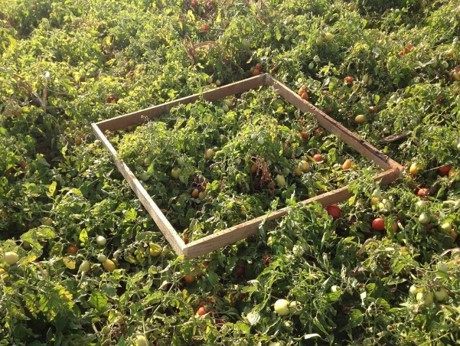Plant density and growth regulator applications in a tomato crop for industrial processing

Abstract
Growth regulators are used in agriculture to reduce vegetative growth, promote flowering and fruiting processes, and regulate production alternations. In this study, the effects of the use of paclobutrazol (PBZ) and different plant arrangements on the development and productive yield tomatoes grown for industrial use were evaluated. This experiment was carried out in the experimental area of the Universidade Estadual de Goiás, in a randomized block design with a 2×5 factorial arrangement (presence of PBZ and absence of PBZ in seedlings × planting spacing), with four replications and ten plants per plot. The paclobutrazol (growth regulator) applications were carried out in seedlings 15 days after emergence by applying 3.5 mL of the solution per tray at a concentration of 42.5 mg L-1 using a commercial product containing 25% of the active ingredient for the solution. The spacings were 0.15, 0.20, 0.25, 0.30, and 0.35 m between plants and 1.4 m between rows, corresponding to populations of 47,619; 35,714; 28,714; 23,809 and 20,408 plants/ha, respectively. The initial growth and development of the seedlings, characteristics related to productivity, and the physical and chemical quality of fruits harvested in each experiment were evaluated. It was observed that the application of paclobutrazol influenced the phylotechnical characteristics and technological quality of tomato fruits grown for industrial processing. The planting spacings between 0.21 and 0.27 m had better crop development and productivity.
Keywords
Solanum lycopersicum L., Plant management, Paclobutrazol, Spacing
References
Adolfo Lutz Institute. 1985. Normas analíticas do Instituto Adolfo Lutz. I – Métodos químicos e físicos para análise de alimentos. 3rd ed. Instituto Adolfo Lutz, Sao Paulo, Brazil.
Benetti, R., K.S.S. Benett, N. Arruda, C.G.S. Benett, and A. Seleguini. 2018. Densidade de plantio e substâncias húmicas no cultivo do tomateiro (Solanum lycopersicum L.). Rev. Agric. Neotrop. 5(1), 75-81. Doi: 10.32404/rean.v5i1.2136
Benincasa, M.M.P. 1988. Análise de crescimento de plantas: noções básicas. FUNEP, Jaboticabal, Brazil.
Berova, M. and Z. Zlatev. 2000. Physiological response and yield of paclobutrazol treated tomato plants (Lycopersicon esculentum Mill.). Plant Growth Regul. 30(2). 117-123. Doi: 10.1023/A:1006300326975
Cardoso, M.R.D., F.F.N. Marcuzzo, and J.R. Barros. 2014. Classificação climática de Köppen-Geiger para o Estado de Goiás e o Distrito Federal. Acta Geográf. 8(16), 40-55. Doi: 10.5654/acta.v8i16.1384
Carvalho, L.A. and J. Tessarioli Neto. 2005. Produtividade de tomate em ambiente protegido, em função do espaçamento e número de ramos por planta. Hort. Bras. 23(4), 986-989. Doi: 10.1590/S0102-05362005000400025
Chacón-Padilla, K. and J. Monge-Pérez, 2017. Evaluación de rendimiento y calidad de seis genotipos de pepino de frutos largos (Cucumis sativus L.) cultivados bajo invernadero en Costa Rica, durante la época seca. Rev. Colomb. Cienc. Hortic. 10(2), 323-332. Doi: 10.17584/rcch.2016v10i2.5069
Evert, R.F., S.E. Eichhorn, and C.M. Vieira. 2017. Biologia vegetal. 8th ed. Guanabara Koogan, Rio de Janeiro, Brazil.
Ferreira, N.C., E.P. Vendruscolo, A. Seleguini, W.D.S. Dourado, C.S.G. Benett, and A.D.R. Nascimento. 2017. Crescimento, produção e qualidade de frutos de tomateiro em cultivo adensado com uso de paclobutrazol. Rev. Colomb. Cienc. Hortic. 11(1), 72-79. Doi: 10.17584/rcch.2017v11i1.5690
Figueiredo, A.S.T., L. Meert, J.T. de Paula, J.T.V. de Resende, J.D. Rodrigues, and E.O. Ono. 2015. Comportamento de plantas de tomateiro indeterminado na presença de regulador de crescimento. Campo Digital 10(1), 31-40.
Fontes, P.C.R. and D.J.H. Silva. 2005. Cultura do tomate. pp. 457-475. In: Rezende, P.C. (ed.). Olericultura: teoria e prática. Universidade Federal de Viçosa, Viçosa, Brazil.
Hachmann, T.L., M.M. Echer, G.M. Dalastra, E.S. Vasconcelos, and V.F. Guimarães. 2014. Cultivo do tomateiro sob diferentes espaçamentos entre plantas e diferentes níveis de desfolha das folhas basais. Bragantia 73(4), 399-406. Doi: 10.1590/1678-4499.0163
IBGE, Instituto Brasileiro de Geografia e Estatística. 2020. Levantamento sistemático da produção agrícola. In: https://sidra.ibge.gov.br/tabela/1618; consulted: January, 2020.
Monteiro, C.S., M.E. Balbi, O.G. Miguel, P.T.P.S. Penteado, and S.M.C. Haracemiv. 2008. Qualidade nutricional e antioxidante do tomate “tipo italiano”. Alim. Nutr. 19(1), 25-31.
Mueller, S. and A.F. Wamser. 2009. Combinação da altura de desponte e do espaçamento entre plantas de tomate. Hort. Bras. 27(1), 064-069. Doi: 10.1590/S0102-05362009000100013
Naika, S., J.V.L. Jeude, M. Goffau, M. Hilmi, and B.V. Dam. 2006. A Cultura do tomate. Fundação Agromisa e CTA, Wageningen, The Netherlands.
Ribeiro, A.C., P.T.G. Guimarães, and V.H.V. Alvares. 1999. Recomendação para o uso de corretivos e fertilizantes em Minas Gerais: 5ª aproximação. 5th ed. Comissão de Fertilidade do Solo do Estado de Minas Gerais, Viçosa, Brazil.
Santos, H.G., P.K.T. Jacomine, L.H.C. Anjos, V.A. Oliveira, J.F. Lumbreras, M.R. Coelho, J.A. Almeida, T.J.F. Cunha, and J.B. Oliveira. 2013. Sistema brasileiro de classificação de solos. 3rd ed. Embrapa, Brasilia.
Schwarz, K.J.T.V., A.P. Resende, J.T. Preczenhak, E. Paula, and D.M. Dias. 2013. Desempenho agronômico e qualidade físico-química de híbridos de tomateiro em cultivo rasteiro. Hort. Bras. 31(3), 410-418. Doi: 10.1590/S0102-05362013000300011
Seleguini, A., M.J.A. Faria Júnior, S. Seno, J.I. Santos, K.S. Silva, and O.L. Lemos. 2011. Vida útil e qualidade de frutos de tomateiros tratados com paclobutrazol. Rev. Ceres 58(4), 470-475. Doi: 10.1590/S0034-737X2011000400010
Seleguini, A., E.P. Vendruscolo, L.F.C. Campos, and M.J.A. Faria Júnior. 2016. Efeito do paclobutrazol sobre o crescimento de plantas e produção de tomate (Solanum lycopersicum L.) em ambiente protegido. Sci. Agropecu. 7(4), 391-399. Doi: 10.17268/sci.agropecu.2016.04.04
Silva, C.M.M.S. and E.F. Fay. 2003. Impacto ambiental do regulador de crescimento vegetal paclobutrazol. Embrapa Meio Ambiente, Jaguariúna, Brazil.
Silva, K.S., C.G.S. Benett, A. Seleguini, R.C. Lima, M.J.A. Faria Junior, and S. Seno. 2008. Uso de paclobutrazol no cultivo de tomateiro em campo e ambiente protegido: I. Crescimento de plantas e emissão de brotos laterais. Hort. Bras. 26(2), 256-260.
Silva, K.S. and M.J.A. Faria Junior. 2011. Uso de paclobutrazol como estratégia para redução do porte e da brotação lateral de plantas de tomateiro. Ciênc. Agrotec. 35(3), 539-546. Doi: 10.1590/S1413-70542011005000004
Taiz, L. and E. Zeiger. 2013. Fisiologia vegetal. 5th ed. Artmed, Porto Alegre, Brazil.
Wamser, A.F., S. Mueller, A. Suzuki, W.F. Becker, and J.P. Santos. 2012. Produtividade de híbridos de tomate submetidos ao cultivo superadensado. Hort. Bras. 30(1), 168-174. Doi: 10.1590/S0102-05362012000100028
Zonta, E.P., A.A. Machado, and P. Silveira Junior. 1987. Sistema de análise estatística para microcomputadores: manual de utilização. 2nd ed. UFPel, Pelotas, Brazil.
